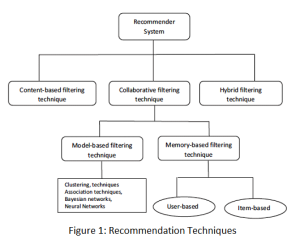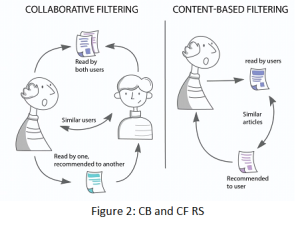Mohsin Hasan Hussein & Rand Abdulwahid Albeer
College of Computer Science and Information Technology
The term information overload arose with the accelerated development of information technology. Every day, we are inundated with choices and options, what to wear? What movie to watch? What product to buy? what blog post to read? The sizes of these decision domains are frequently massive.
Recommender systems (RS) are seeing significant academic, economic and industry interest. It can be considered an important part of the e-commerce ecosystem, and reduce a large amount of data to a manageable amount and recommends it to the user according to his interests, desires, and choices [1].
It is difficult to choose from thousands of options without the help or advice of someone who has prior knowledge of the product. For example, when you go to the movies, you ask the ticket seller about the best or most popular showing. Similarly, you may consult a friend who shares your ideas and opinions about a product that he has already purchased and utilized. These suggestions are limited to friends and relatives. With the development of technology and techniques, we can now benefit from the opinions of people we may not know and in other places. In addition, at present, there are thousands of sales sites that market their products electronically. For example, the Amazon Company, which is considered one of the most important and largest companies in the world, depends mainly on customers’ evaluations of the products. This leads to an increase in the company’s sales and profits. The sale of recommended materials increases more than other materials that did not receive a recommendation. It also leads to the sale of different materials that may be difficult for the user to find without a recommendation. In addition to that, the recommendation system enables the company to know the needs of its customers [2]. There are several applications where recommendation systems can be used, such as e-learning [3], e-commerce [4] and news [5].
The RS is addressed in several research disciplines, such as: Information filtering, Information retrieval, Approximation theory, Machine learning, Cognitive science and Human-computer interaction. Such systems rely on the principle of machine learning. They learn from customer behaviour, for example, previous purchase records or previous evaluation, and then recommend an interesting product.
The recommendation system is mainly based on the feedback information. RSs gather information on customer choices for a collection of products (e.g., books, movies, music, apps, websites, etc.), which can be obtained either explicit or implied. Explicit data is collected from direct user input, for example, reviews and comments on the product. While implicit data is collected from the user’s search history, the number of views, or from the content of the shopping cart etc. It can be created for each user who visits the site. Another type of feedback information is to use some additional information such as users’ demographic information and/or social information. Indeed, RSs have developed in line with the web, where social information has become integral part of such RS systems.
The process of collecting information is easier than analyzing the data and separating the necessary records from the less important ones [2].
From an architectural and algorithmic point of view, personalization systems fall into three basic categories: content-based filtering systems, collaborative filtering systems and hybrid filtering[6] as shown in figure (1)
Content-based filtering systems are domain-dependent algorithms that focus on the analysis of the item’s attributes for generating predictions. It is based on the features and properties of the item which the user evaluated in the past [6][7].
The basic high steps of the CB recommendation system are [8]:
⦁ Generating a quantitative model to represent the actual content of each product.
⦁ Building a user profile using the model and user feedback (for example, ratings or reviews). This profile is simply a classifier that learns to predict the user’s ratings of the modelled objects with high accuracy.
⦁ Finally, in the model system, each product not tried by the user is added to its profile to determine an approximate rating. The highest-rated objects become the most highly recommended items for that user.
This system does not depend mainly on the user’s rating of the product. Therefore, it is considered useful, especially in data sets that are characterized by a few or lack of ratings [8].
Collaborative filtering systems are filtering based on the behaviours and interests of other people in the system. They rely on the behaviours of others to provide an appropriate suggestions for the active user. If a group of users agree on the importance or usefulness of some products, the CF system can recommend the rating of one of the people to others [1]. Figure (2) explains the difference between the CB and CF RS.
There are two basic categories in the CF filter: Memory-based and Model-based. Memory-based approaches compute the similarity between users or products based on user ratings of past data. The concept behind these strategies is to create a measure of similarity between users or objects and then identify the most similar to propose previously unknown items. Model-based approaches depend on predicting users’ rating of unwell rated or unrated items. This relies on the principle of machine learning. These techniques may rapidly suggest a group of items because they employ a pre-computed model. It compares the list of top-N suggestions by analysing the user-item matrix and identifying relationships between things. Model-based strategies address the sparsity issues affecting recommendations [7].
Hybrid filtering is a combined model which gathers the two systems (content-based and collaborative filter) for more accurate prediction and to cure the flaws of each individual strategy. There are many successful systems that use this model. It can be made in any of the following methods: individually implementing algorithms and merging the results, applying some content-based filtering in a collaborative method, applying some collaborative filtering in a collaborative approach and constructing a unified recommendation system that combines both techniques [2][7][8].
References
[1] M. D. Ekstrand, J. T. Riedl, and J. A. Konstan, “Collaborative filtering recommender systems,” Found. Trends Human-Computer Interact., vol. 4, no. 2, pp. 81–173, 2010, doi: 10.1561/1100000009.
[2] F. Ricci, L. Rokach, B. Shapira, and P. B. Kantor, Recommender Systems Handbook. 2011.
[3] A. Klašnja-Milićević, M. Ivanović, and A. Nanopoulos, “Recommender systems in e-learning environments: a survey of the state-of-the-art and possible extensions,” 2015, doi: https://doi.org/10.1007/s10462-015-9440-z.
[4] M. S. Ackerman, L. F. Cranor, and J. Reagle, “Privacy in E-Commerce: Examining User Scenarios and Privacy Preferences,” Accessed: Apr. 20, 2022. [Online]. Available: http://www.ics.uci.edu/~ackermanhttp://www.research.att.com/~lorriehttp://www.w3.org/People/Reagle.
[5] M. Karimi, D. Jannach, and M. Jugovac, “News recommender systems – Survey and roads ahead,” 2018, doi: https://doi.org/10.1016/j.ipm.2018.04.008.
[6] D. Jannach, M. Zanker, A. Felfernig, and G. Friedrich, Recommender systems: an introduction. 2010.
[7] F. O. Isinkaye, Y. O. Folajimi, and B. A. Ojokoh, “Recommendation systems: Principles, methods and evaluation,” Egypt. Informatics J., vol. 16, no. 3, pp. 261–273, 2015, doi: 10.1016/j.eij.2015.06.005.
[8] J. Cho, J. Watanabe-inouye, A. Prof, and A. Rafferty, “Book Recommendation System,” pp. 1–12, 2016.































































